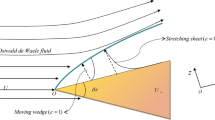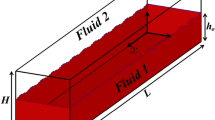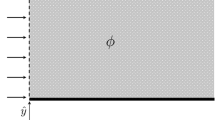Abstract
The flow of two superposed viscous fluid layers in a two-dimensional channel confined between a plane and a wavy or indented wall is studied by analytical and numerical methods at arbitrary Reynolds numbers. The interface between the two fluids may exhibit constant or variable surface tension due to an insoluble surfactant. The flow is computed from a specified initial condition using the immersed-interface method on a curvilinear grid constructed by conformal mapping. The numerical simulations illustrate the effect of geometrical nonlinearity and reveal that inertia may increase or decrease the amplitude of the interface profile at steady state depending on the flow parameters. Increasing either the Reynolds number or the wall amplitude above a certain threshold value provokes flow instability and overturning of the interface. In the Appendix, a linear perturbation analysis is performed for arbitrary Reynolds numbers on the assumption of small-amplitude sinusoidal undulations, and results for the amplitude and phase shift of the interfacial and surfactant concentration wave are documented for a broad range of flow conditions. It is found that inertia may have a mixed effect on the deformation and phase shift, while the surfactant promotes the deformation of the interface under most conditions.
Similar content being viewed by others
References
Cabal A, Szumbarski J and Floryan JM (2002). Stability of flow in a wavy channel. J Fluid Mech 457: 191–212
Floryan JM (2005). Two-dimensional instability of flow in a rough channel. Phys Fluids 17(4): 044101
Wang CY (1981). Liquid film flowing slowly down a wavy incline. AIChE J 27: 207–212
Kang F and Chen K (1995). Gravity-driven two-layer flow down a slightly wavy periodic incline at low Reynolds numbers. Int J Multiphase Flow 21: 501–513
Pozrikidis C (2003b). Effect of surfactants on film flow down a periodic wall. J Fluid Mech 496: 105–127
Vlachogiannis M and Bontozoglou V (2002). Experiments on laminar film flow along a periodic wall. J Fluid Mech 457: 133–156
Wierschem A, Scholle M and Aksel N (2003). Vortices in film flow over strongly undulated bottom profiles at low Reynolds numbers. Phys Fluids 15: 426–435
Luo H and Pozrikidis C (2006). Shear-driven and channel flow of a liquid film over a corrugated or indented wall. J Fluid Mech 556: 167–188
Li X and Pozrikidis C (1997). The effect of surfactants on drop deformation and on the rheology of dilute emulsions in Stokes flow. J Fluid Mech 341: 165–194
Pozrikidis C (2001). Interfacial dynamics for Stokes flow. J Comp Phys 169: 250–301
Adamson AW (1990). Physical chemistry of surfaces. Wiley, London
Pozrikidis C (2004). Instability of multi-layer channel and film flows. Adv Appl Mech 40: 179–239
Peskin CS (2002). The immersed boundary method. Acta Numerica 11: 479–517
Pozrikidis C (2004). Effect of inertia on the Marangoni instability of two-layer channel flow, Part I: numerical simulations. J Engng Math 50: 311–327
Blyth MG, Luo H and Pozrikidis C (2006). Stability of axisymmetric core-annular flow in the presence of an insoluble surfactant. J Fluid Mech 548: 207–235
Caponi EA, Fornberg B, Knight DD, Mclean JW, Saffman PG and Yuen HC (1982). Calculations of laminar viscous flow over a moving wavy surface. J Fluid Mech 124: 347–362
Pozrikidis C (1997). Introduction to theoretical and computational fluid dynamics. Oxford University Press, New York
Pozrikidis C (2003). On the relationship between the pressure and the projection function for the numerical computation of incompressible flow. Euro J Mech B / Fluids 22: 105–121
Yon S and Pozrikidis C (1998). A finite-volume / boundary-element method for flow past interfaces in the presence of surfactants, with application to shear flow past a viscous drop. Computers and Fluids 27: 879–902
Luo H and Bewley TR (2004). On the contravariant form of the Navier–Stokes equation in time-dependent curvilinear coordinate systems. J Comp Phys 199(1): 355–375
Blyth MG and Pozrikidis C (2004). Evolution equations for the surface concentration of an insoluble surfactant; stability of an elongating thread and a stretched interface. Theor Comp Fluid Dyn 17(3): 147–164
Gottlieb D and Orszag SA (1977). Numerical analysis of spectral methods. SIAM, Philadelphia
Dongarra JJ, Straughan B and Walker DW (1996). Chebyshev tau-QZ algorithm methods for calculating spectra of hydrodynamic stability problems. Appl Num Math 22: 399–434
Author information
Authors and Affiliations
Corresponding author
Rights and permissions
About this article
Cite this article
Luo, H., Blyth, M.G. & Pozrikidis, C. Two-layer flow in a corrugated channel. J Eng Math 60, 127–147 (2008). https://doi.org/10.1007/s10665-006-9134-2
Received:
Accepted:
Published:
Issue Date:
DOI: https://doi.org/10.1007/s10665-006-9134-2




